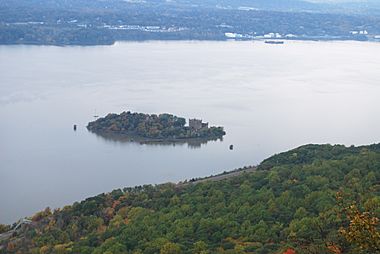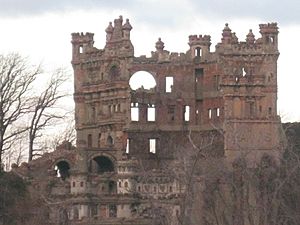Pollepel Island facts for kids

Pollepel Island is a small, uninhabited island in the Hudson River in New York. It is about 6.5 acres in size. The most famous thing on the island is Bannerman's Castle. This castle is an old, abandoned warehouse that once stored military supplies.
Contents
About Pollepel Island
Pollepel Island has been called many different names over time. Some of these names include Pollopel Island and Bannerman's Island. The word Pollepel comes from Dutch and means "pot ladle" or "spoon."
The island is located about 50 miles north of New York City. It is also about 1,000 feet away from the eastern bank of the Hudson River. Most of the island's 6.5 acres are made up of rock.
Pollepel Island's Early History
Europeans first discovered Pollepel Island when Dutch settlers explored the Hudson River. This happened in a part of the river called the "Northern Gate" of the Hudson Highlands.
During the American Revolutionary War, American patriots tried to stop the British army. They wanted to prevent British ships from sailing up the river. To do this, they placed 106 large obstacles, called chevaux de frise, in the water. These were upright logs with sharp iron points. They stretched between the island and Plum Point across the river. Some parts of these obstacles are still at the bottom of the river today. However, these barriers did not stop a British fleet from burning Kingston in 1777.
Later, George Washington, who was a general, signed a plan to use the island as a military prison. But there is no proof that a prison was ever actually built there.
Bannerman's Castle
Quick facts for kids |
|
|
Bannerman's Island Arsenal
|
|

Remains of Bannerman Castle viewed from the railroad on the eastern bank of the Hudson River, circa 2003
|
|
| Lua error in Module:Location_map at line 420: attempt to index field 'wikibase' (a nil value). | |
| Location | Pollepel Island, Newburgh, New York |
|---|---|
| Area | 13.4 acres (5.4 ha) |
| Built | 1901 |
| Architect | Bannerman, Francis VI |
| MPS | Hudson Highlands MRA |
| NRHP reference No. | 82001121 |
| Added to NRHP | November 23, 1982 |
How Bannerman's Castle Started
Francis Bannerman VI was born in Scotland on March 24, 1851. He moved to the United States with his parents in 1854. His family started a business in 1865 that sold leftover military equipment. They bought these supplies after the American Civil War ended.
The business grew and even helped outfit volunteers for the Spanish–American War in 1897. Bannerman bought many weapons and supplies directly from the Spanish government. He also bought most of the Spanish guns and equipment captured by the U.S. military. His mail-order catalog, which showed all his items, became very popular. It was even used by collectors of old military gear.
In November 1900, Bannerman bought Pollepel Island. He needed a safe place to store his huge collection of military items. His store in New York City was not big enough for 30 million ammunition cartridges. So, in the spring of 1901, he started building a large storage castle on Pollepel Island. Bannerman designed the buildings himself.
Most of the castle was used to store military surplus. But Bannerman also built a smaller castle on top of the island to live in. He often used items from his military collection to decorate his home. The castle was easy to see from the river. It acted like a giant advertisement for his business. On the side of the castle facing the western bank of the Hudson, Bannerman had the words "Bannerman's Island Arsenal" carved into the wall.
Around 1900–1910, the U.S. Navy updated some of its older ships. Bannerman bought the old guns from these ships. In 1917, when the United States joined World War I, Bannerman sold some of these weapons to the U.S. Army. The Army planned to use them as field guns on the Western Front.
Construction on the castle stopped when Bannerman passed away in 1918. In August 1920, an explosion of shells and powder destroyed part of the complex. Over time, Bannerman's sales of military weapons to people declined. This was due to new state and federal laws. In 1950, a storm sank the ferryboat Pollepel, which served the island. After this, the castle and island were mostly left empty.
New York State bought the island and its buildings in 1967. The old military items were removed and given to the Smithsonian museum. For a short time in 1968, tours of the island were offered. However, a big fire on August 8, 1969, badly damaged the castle. The roofs and floors were destroyed. After the fire, the island was closed to the public for safety.
Bannerman's Castle Today

Today, Bannerman's Castle is owned by the New York State Office of Parks, Recreation and Historic Preservation. It is mostly in ruins. Parts of the outer walls still stand, but all the inside floors and walls burned down. The island has faced problems like vandalism and neglect. Some old docks and walkways that go underwater at high tide can be dangerous for boats.
Since 2004, guided tours of the island have been offered by the Bannerman's Castle Trust. The castle is easy to see for people riding the Metro-North Railroad Hudson Line and Amtrak trains. One side of the castle, which still has the words "Bannerman's Island Arsenal," is visible to southbound train riders.
Around December 2009, parts of the castle collapsed. Officials believe about 30–40 percent of the front wall and half of the east wall fell.
In June 2015, a public art project called Constellation was created on and around the castle ruins. It was made by artist Melissa McGill. The artwork has seventeen LED lights on metal poles of different heights. When lit each night, they look like a new constellation in the sky.
The Bannerman Castle Trust helps maintain the island. This non-profit group of volunteers raises money to fix and improve the structures on Pollepel Island. They also teach people about the island's history. The Trust continues to offer guided tours of the island.



